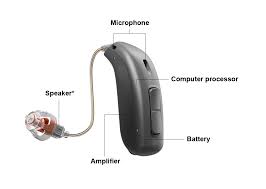How Hearing Aids Work

Hearing aids have become incredibly small pieces of digital technology. Even these little devices can improve the quality of communication for many people with hearing loss. So, how do hearing aids work? Well, let’s find out! While most hearing aids have the same basic components, some will have modifications based on the wearers’ needs. Here is a basic overview of how the most common hearing aids work.
Basic Hearing Aid Components
As mentioned, all hearing aids have the same 4 basic components: microphones, an amplifier, a receiver, and a battery.
- Microphones – The microphones take in the sound and turn it into electrical signals
- Amplifier – The amplifier increases the strength of the signal to your prescription
- A Receiver or Speaker – The receiver or speaker takes that signal delivers a louder sound to your ears
- Battery – The battery, disposable or rechargeable, powers the whole process
Sounds simple, right? But a lot happens in those 4 little parts in addition to some other components that can be involved.
Other Components
While these other components don’t necessarily change the process for how the sound enters your ear, they can manipulate how you experience the sound.
- Domes or Custom molds – at the end of the receiver there is always a little rubber dome or a custom mold. Based on the size, shape, and style of the dome or mold, it will change how the sound enters your ear.
- Wax filters – another part of the receiver, most have a wax filter to catch, you guessed it, wax before it gets to the internal components. If this gets plugged, the sound can’t get through.
- Bluetooth – most hearing aids on the market now have Bluetooth capabilities. With this, you can stream phone calls, TV, and other media directly to your hearing aids!
- Buttons for volume or program control – many hearing aids have buttons that allow the wearer to make small modifications to how they hear.
Other features or components can be added based on the client’s unique needs and wants.
How It All Works
In a simplified explanation, let’s look at 2 examples:
Having a conversation
The battery powers the hearing aids. Once they are in your ears, the microphones are picking up the voice of the person talking and the other sounds around you. As the sound comes into the microphones it’s turned into electrical signals so the amplifier can increase the voice sounds, suppress the background noise, and any other features that have been set up for you. This modified signal is sent to the receiver/speaker as sound again and delivered to your ears.
Streaming a phone call
The battery powers the hearing aids. Now, you get a phone call to your phone that is paired to your hearing aids via Bluetooth. The microphones are automatically turned down. The Bluetooth sends the sounds directly to the amplifier has electrical signals. The amplifier can then increase the signals to your prescription. This modified signal is then sent to the receiver/speaker as sound again and delivered to your ears.
That’s how hearing aids work, and it all happens in milliseconds! Cool right!
YouTube link: https://youtu.be/AxzVyMcmRcs
These small aids can do amazing things in a short period of time. If you or someone you know is struggling to hear in conversations or other activities of daily life, hearing aids might be a small, helpful tool for them. For more information or to schedule an appointment, call us at 705-749-0707.



Recent Comments